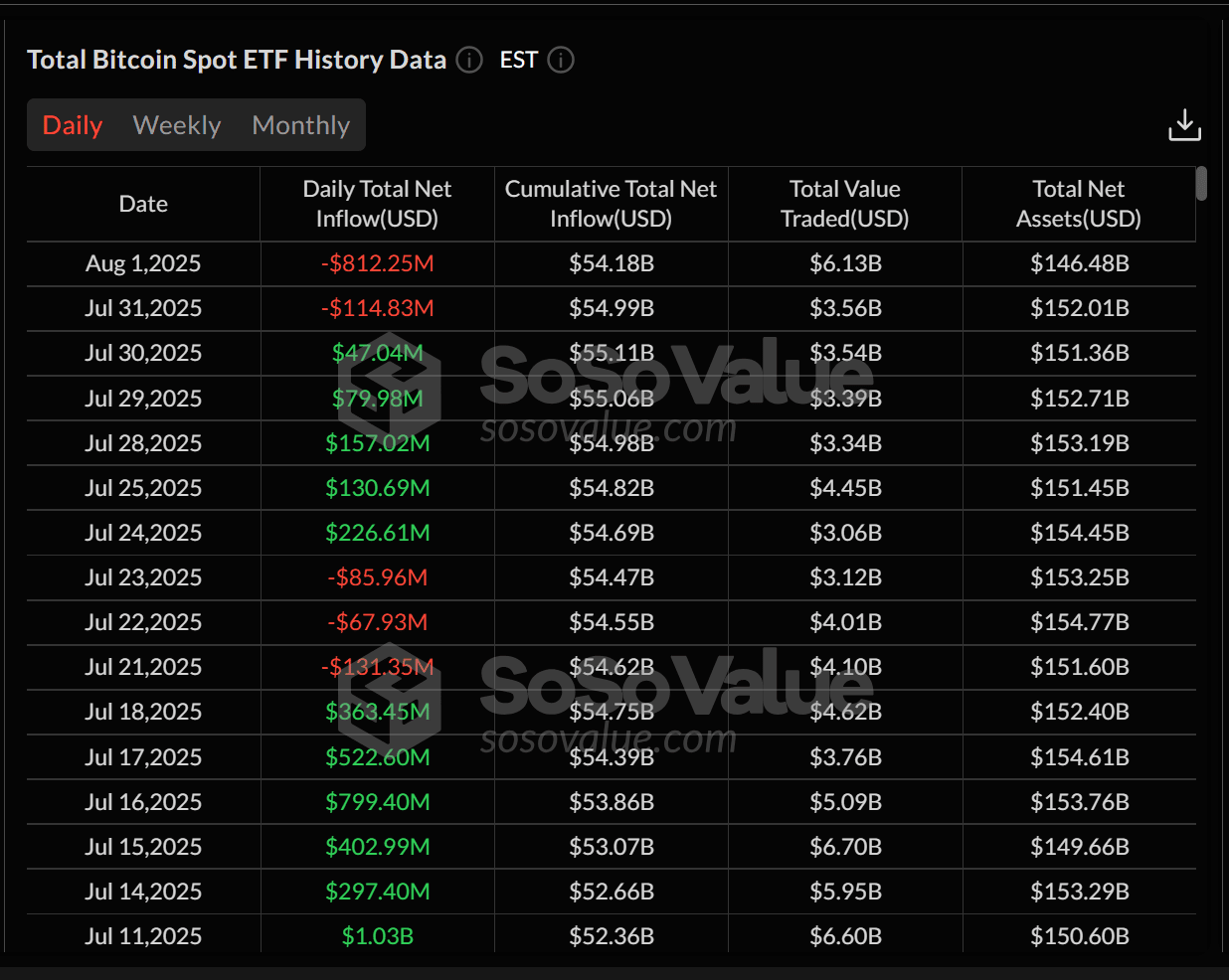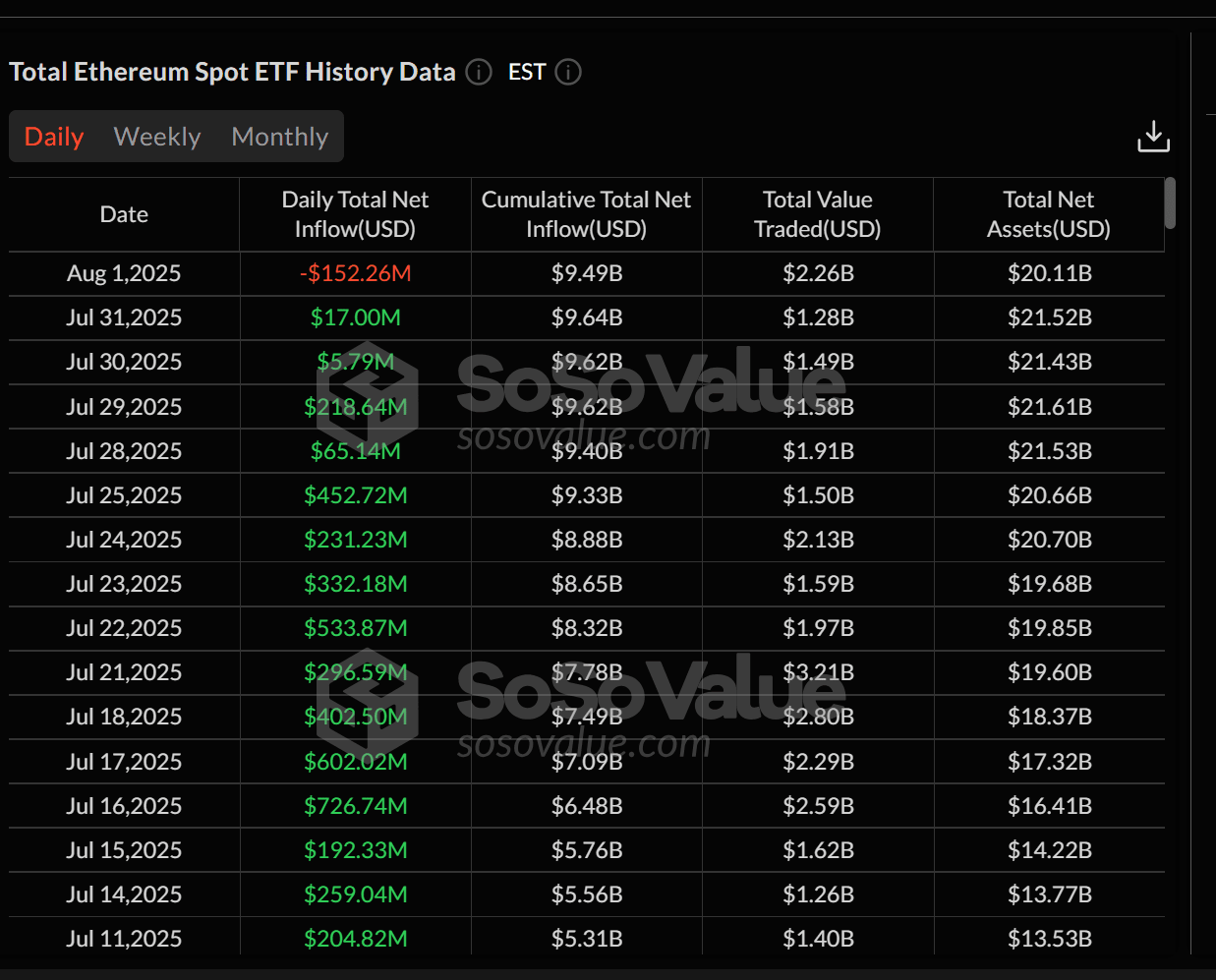On August 1, the Bitcoin ETF experienced an outflow of $812 million, led by Fidelity and ARK, while Ethereum ETF ended its 20-day inflow streak with a loss of $152 million, reflecting significant market adjustments.
Bitcoin and Ethereum ETFs face large-scale outflows, indicating a shift in cryptocurrency investment trends. Follow professional market analysis from COINOTAG to stay updated on the latest developments.
Market volatility leads to record outflows from Bitcoin ETF.
On August 1, the spot Bitcoin exchange-traded fund (ETF) faced a significant setback with a net outflow of $812.25 million, marking its second-largest single-day loss in history. This reversal wiped out a week's gains, bringing the cumulative net inflow down to $54.18 billion, with total assets under management falling to $146.48 billion, accounting for 6.46% of Bitcoin's market capitalization. Fidelity's FBTC led the redemption amounts with $331.42 million, followed closely by ARK Invest's ARKB at $327.93 million. Despite these outflows, trading activity remains strong, with total trading volume for all spot Bitcoin ETFs reaching $6.13 billion, underscoring ongoing investor participation.

Outflows from Bitcoin ETF. Source: SoSoValue
What caused the significant decline in Bitcoin ETF assets?
The outflow of funds primarily stems from profit-taking and portfolio rebalancing by investors during recent market volatility. Fidelity's FBTC and ARK's ARKB products faced the largest redemption impacts, reflecting a shift in investor sentiment. BlackRock's IBIT ETF experienced minimal losses, indicating selective confidence among investors in certain Bitcoin products. Market analysts note that despite the outflow, high trading volumes suggest ongoing investor interest in Bitcoin ETFs as a strategic asset class.
Ethereum ETF ended its longest inflow streak, experiencing significant outflows.
The Ethereum ETF ended its longest inflow streak after 20 trading days, with a net outflow of $152.26 million on August 1. Currently, its total assets under management reach $20.11 billion, accounting for 4.70% of Ethereum's market capitalization. Grayscale's ETHE leads with a net outflow of $47.68 million, followed by Bitwise's ETHW with a net outflow of $40.30 million. Fidelity's FETH also saw a net outflow of $6.17 million, while BlackRock's ETHA remained stable with assets of $10.71 billion and no net outflow. The sector's total trading volume was $2.26 billion, with Grayscale's ETH products accounting for the largest share at $288.96 million, highlighting ongoing market volatility.

Ethereum ETF has ended its 20-day inflow streak. Source: SoSoValue
How has the Ethereum ETF performed in recent market trends?
At the beginning of July, the inflow of Ethereum ETF reached a record, with a peak daily inflow of $726.74 million on July 16, soaring to $602.02 million the next day. This surge reflects a growing interest from investors in Ethereum products, driven by bullish sentiment. Recent fund outflows mark a temporary slowdown in this momentum but do not negate its underlying demand. Market experts emphasize that the expanding use cases of Ethereum in DeFi and Staking will continue to support investors' long-term interest.
Why is the pace of corporate accumulation of Ethereum faster than that of Bitcoin?
According to a recent report from Standard Chartered, the pace at which corporations are acquiring Ethereum is twice that of Bitcoin. Since June, cryptocurrency asset management firms have accumulated approximately 1% of Ethereum's circulating supply. This corporate demand, combined with stable inflows into U.S. spot Ethereum ETFs, is a significant driver of Ethereum's price increase. The report predicts that, driven by staking rewards and participation in decentralized finance, the holdings of Ethereum asset management firms could grow to 10% of the total supply, potentially pushing Ethereum's price above $4,000 by year-end.
What impact does corporate accumulation have on the Ethereum market?
Corporate hoarding has reduced available supplies, exacerbating scarcity and potentially driving up prices. The integration of staking and DeFi incentive mechanisms further enhances ETH's appeal as a strategic asset. Financial institutions view ETH as a versatile digital asset that supports both investment and operations, solidifying its market position relative to Bitcoin.
Frequently Asked Questions
What is the main reason for the $812 million outflow from Bitcoin ETF?
The $812 million outflow from Bitcoin ETF is primarily due to profit-taking and portfolio adjustments by investors responding to recent market volatility. Fidelity's FBTC ETF and ARK's ARKB ETF experienced the largest outflows.
Why did the Ethereum ETF end its 20-day inflow streak?
Despite strong potential demand driven by corporate accumulation and DeFi growth, the Ethereum ETF ended its 20-day inflow streak due to short-term market volatility and investor profit-taking.
Key Points
Bitcoin ETF saw an outflow of $812 million, marking the second-largest single-day loss, signaling market volatility.
Ethereum ETF ended a 20-day inflow streak with an outflow of $152 million, reflecting profit-taking after strong previous demand.
Corporate accumulation of Ethereum is accelerating: driving scarcity and supporting a price target above $4,000.
Conclusion
The recent large outflows from Bitcoin and Ethereum ETFs highlight the dynamic changes in cryptocurrency investment patterns. Although there has been a short-term outflow of funds, the sustained trading volume and corporate accumulation of Ethereum underscore investor confidence in these digital assets. Investors and market observers should closely monitor the fund flows and institutional activities of ETFs as key indicators of future market direction.